Crude oil prices dropped below zero for the first time in history on April 20, 2020. Many were scratching their head in disbelief as the U.S. oil prices turned negative. Others were amused as they watched the deepest fall in demand for the “black gold” in 25 years. It’s not everyday you get to watch crude oil crashed from US$18 a barrel to -US$38 in a matter of hours.
Oil producers actually had to pay buyers US$40 a barrel to take oil off their hands simply because the storage facilities were full to the brim. It was the first impact of the Coronavirus outbreak on oil, as demand plunged to its lowest levels since 1995. Actually, oil producers knew it as the price of oil had been steadily falling across the global markets since the outbreak in China at the end of 2019.
For about 4 months, oil producers saw major economies being shut down and transport grounded to a halt to curb the spread of the virus. But oil producers continued to pump near-record levels of crude oil in the global market as if nothing was happening, causing the catastrophic imbalance between supply and demand. The expiration of May crude oil contract had worsened the situation.

From April to August, the WTI crude oil prices steadily climbed to above US$40 but failed to reach US$45. Today, West Texas Intermediate (WTI) plunged as much as 6% to US$33.64 a barrel, while the Brent dropped as much as 4.6% to US$35.74 a barrel – hitting their lowest levels since May. And it could only get worse, if the Covid-19 situations in the U.S. and Europe are any indicator.
On Friday (Oct 30), the United States hit another new record for the wrong reason. In spite of President Donald Trump’s boastful claims that the U.S. has “rounded the corner” on Covid-19 and the virus “will go away”, the country reported 100,233 new infections on Friday alone – the most cases ever reported in a single day by a country in the world.
Interestingly, it was only 91,000 cases a day earlier, meaning the U.S. has added about 10,000 new infections within 24-hour period. To make matters worse, on the same Friday, a whopping 16 U.S. states reported their highest one-day Coronavirus infections. There were also 14 states reported their highest number of Covid-19 hospitalizations on the same day.
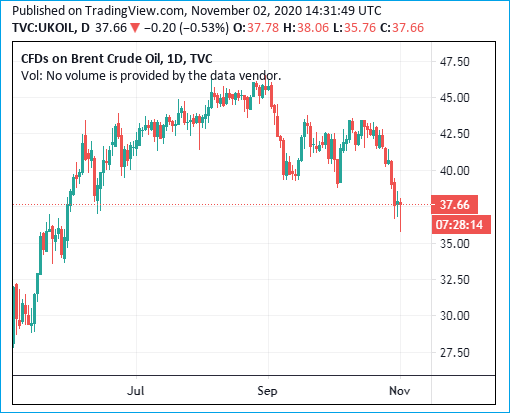
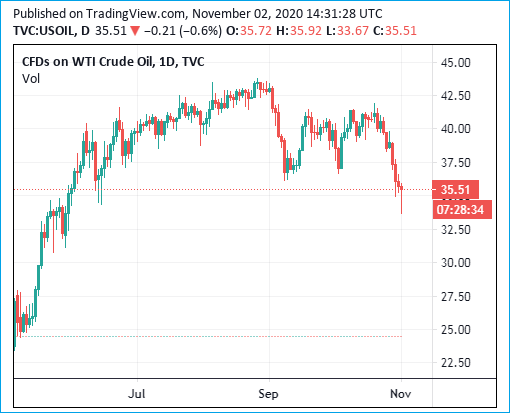
In essence, the great nation is now reporting more than one new case every second. In just 14 days, the number of infections in the country has jumped from 8-million marks to 9-million milestones. The U.S. has also snatched the trophy from India, the country that holds the record of most number of daily Covid-19 cases on Sept 17 – 97,894 cases.
But if you think the U.S. can’t get any worse after breaking the 100,000 daily infections, think again. Scientists have warned that this is just the beginning. Dr. Scott Gottlieb, former U.S. Food and Drug Administration Commissioner, said – “We’re right at the beginning of the steep part of the epidemic curve. You’ll see cases start to accelerate in the coming weeks.”
Gottlieb believed that the current surge in cases would climax around Thanksgiving, hence the month of December could make the 100,000 daily new infections look like child’s play. As recent as early August, White House Coronavirus advisor Dr. Anthony Fauci said the goal was to flatten the curve to below 10,000 daily new cases before September. It never materialised.
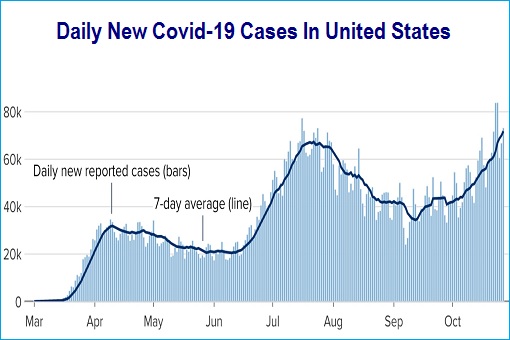
After the initial spike in late March, social distancing restrictions – reluctantly extended for 30 days until 30 April by Trump – gradually brought infections under control. In May, new cases appeared to have had stabilised. But as U.S. states rushed to lift lockdown measures prematurely on 90% of the country’s population, cases began to rise – reaching a new high in July and August.
Beginning September, infections have risen steadily once again. Back to school for students and cold weather, the formula for Coronavirus to survive more easily, are wrecking havoc. It doesn’t help that the virus collides with the U.S. influenza season, which begins in October every year. While economists say America cannot afford another lockdown, nothing is cast in stone.
In Europe, a new wave of lockdowns and business closings has already begun to sweep the continent. French President Emmanuel Macron reluctantly declared a new nationwide lockdown starting from Oct 30 until Dec 1, saying the country has been “overpowered by a second wave” of Coronavirus. Social gatherings are banned and non-essential shops are closed.

German Chancellor Angela Merkel announced a 4-week shutdown of bars, restaurants, gyms, theatres, cinemas, pools and saunas – from Nov 2-30. Social contacts will be limited to two households with a maximum of 10 people. Heckled by the opposition who called her government of “Corona Dictatorship”, Merkel has warned of a long, hard winter ahead of the reinstatement of a national lockdown.
Italy has started its 1-month lockdown much earlier on Oct 26. Spain began its nationwide curfew on Oct 25. Portugal’s lockdown started between Oct 31 and Nov 2. Netherlands has introduced a limited operation hour for businesses in its 4-week partial lockdown. Countries such as Switzerland, Denmark, Portugal, Belgium, Bulgaria and Greece have closed or otherwise clamped down again on nightspots and imposed other restrictions.
In the United Kingdom, British Prime Minister Boris Johnson was forced to announce a month-long shutdown, which will come into effect from Thursday (Nov 5), after the government’s plans were leaked. Even though the new lockdown is expected to last until Dec 2, UK Minister for the Cabinet Office Michael Gove has hinted the second lockdown could be extended beyond the date.
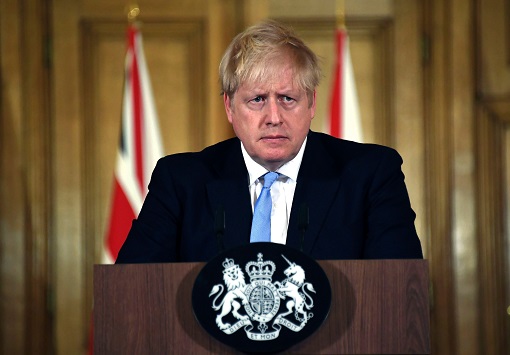
As of Nov 1, the European Union and United Kingdom reported a staggering 7,380,238 infections, with 221,280 deaths. The numbers are not too far away from the United States’ 9,207,364 new cases and 230,996 deaths. Like it or not, the U.S. would have to implement some sort of lockdowns or restrictions, probably after the U.S. presidential election.
And as a result of the new wave of lockdowns across Europe, the oil prices plunged like a rock today (Nov 2) due to fears of weakening fuel demand. If the U.S. decides to impose new restrictions or partial lockdowns, the demand for oil will further be suppressed. Investors are worried that the E.U. is providing a model or scenario of what will happen in the U.S. in the coming weeks.
The chances of a lockdown in the U.S. are very high if President Donald Trump, already trailing Democratic challenger Joe Biden in national opinion polls, loses. The only good news for oil producers is China, whose factory activity expanded for the sixth straight month in October. The Caixin/Markit Purchasing Managers’ Index for Chinese manufacturing recorded 53.6 for October, better than the 53.0 forecast.

Still, on top of the weakening demand, the energy industry also sees rising supplies from OPEC, the same scenario in April when the oil price tumbled below zero dollars a barrel. Libya and Iraq have been pumping so much oil that their exports offset production cuts by other members of OPEC and Russia, known as OPEC+.
In October, OPEC oil production has increased for the “fourth consecutive month”. It pumped 24.59 million barrels per day (bpd) – up 210,000 bpd from September. September production, in turned, saw an increase by 160,000 bpd compared to August. In short, October’s increase means OPEC was pumping about 2.2 million bpd more than the month of June.
As expected, everyone cheated. Compliance issue saw Saudi Arabia, Russia, Nigeria, Iraq and even the United Arab Emirates (UAE) exceeded their quota. In August, the UAE was exposed as the worst quota-breaker when it pumped a whopping 250,000 bpd above quota. Saudi Energy Minister Prince Abdulaziz said – “Using tactics to over-produce and hide non-compliance have been tried many times in the past.”
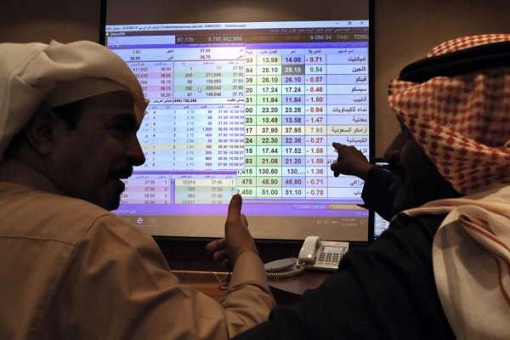
OPEC+ agreed in July to cut their crude oil production by 7.7-million bpd from August through to December this year, in an effort to rebalance the market. The adjustment from an initial 9.7-million bpd cut was to add 2-million barrels per day to the market as the 23-producer group believed the demand was returning to normal levels.
If that was not bad enough, OPEC+ has another plan to boost an extra 2-million bpd in Jan 2021 – to reduce current 7.7 million bpd cut to 5.7 million bpd from January through April 2021. Now, they are not sure anymore. Saudi and Russia are in favour of maintaining the group’s current output reduction (7.7 million bpd) into next year in the face of lockdowns in Europe and rising Libyan oil output.
Not every member of OPEC can handle more cuts, including Saudi’s closest allies UAE and Kuwait. The UAE is now pumping less than 2.6 million bpd, a significant decrease from 3.9 million bpd it pumped back in April. Likewise, Kuwait is producing slightly less than 2.3 million bpd, down from around 3.1 million bpd prior to the OPEC cuts. Everyone needs to balance their budget deficits.

With the return of Libya to the market and new rounds of lockdowns in Europe (and perhaps the U.S.), oil prices are expected to drop again should Joe Biden wins the White House. President Biden, like Barack Obama, may strike an agreement that would return Iran to the market. Even now, Iran has increased its oil output and sells them to China and Syria – secretly.
Other Articles That May Interest You …
- Here’s How Trump Easily Brokered The Oil Supply Deal – He Threatened To Remove U.S. Troops From Saudi Arabia
- Kaboom! Biggest 1-Day Drop In History – Oil Is Now Below $10, And It Could Stay There For Some Time
- IMF – The “Great Lockdown” Is Set To Triggers The World’s Worst Recession Since The 1929 Great Depression
- Kaboom! – Oil Plunges Below $28, Oil-Reliant Countries Are Set To Lose Revenue By Up To 85%
- Get Ready For $20 Oil – All Eyes On “Russia vs Saudi” After 30% Oil Crash Sparked By Price War
- Get Ready For $30 – Here’s Why Russia Prefers A Meltdown Of Oil Price Than Another Supply Cut Proposed By Saudi
- Forget OPEC – These 3 Powerful Men Will Determine & Control The World Oil Prices
- Here’s How Oil Could Crash To $10 – In 6 To 8 Years
- Meet United States – The World’s Latest Oil Exporter – After 40 Years
- Here’s Why Oil Above $100 Will Never Happen Again, Ever, Forever!!

|
|
November 2nd, 2020 by financetwitter
|


|

|

|

|

|

|




























Comments
Add your comment now.
Leave a Reply